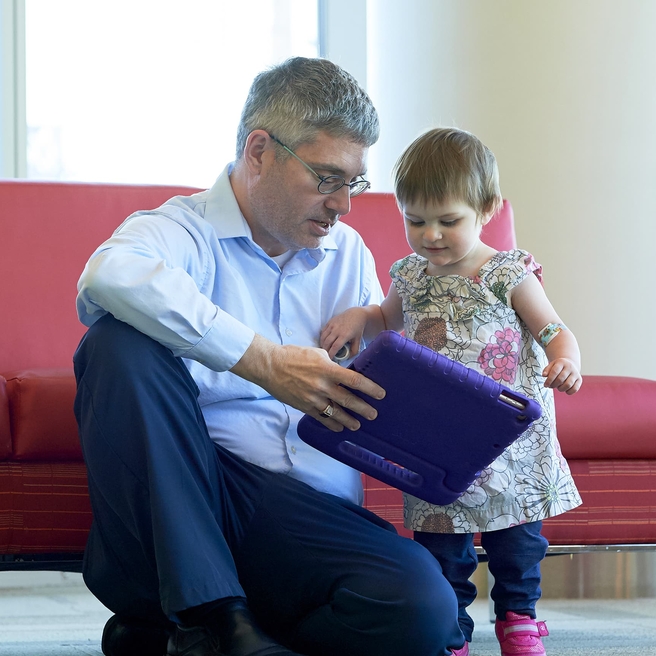What is chronic granulomatous disease (CGD)?
Chronic granulomatous disease (CGD) is a condition that prevents the immune system from fighting off certain infections. The inherited genetic disorder can be life-threatening and life-limiting without accurate diagnosis, customized treatment and long-term observation.
Children with CGD have variations of a critical gene in their immune system that causes a certain type of white blood cells, called neutrophils, not to work properly. Because of this, people with CGD can't fight bacterial and fungal infections effectively. To remain healthy, individuals with CGD need to take daily medication.
Many of the complications seen in patients with CGD are due to chronic inflammation, in addition to the infection itself. Complications can lead to serious illnesses, and in many cases, hospitalization.
CGD is a rare condition, affecting about 8 people per million. At Children's Hospital of Philadelphia (CHOP), we have followed more than 60 patients with CGD, and have treated nearly 30 with cellular therapy in the past 10 years.
Symptoms of chronic granulomatous disease
Children with CGD can easily fight off some infections like viruses, but not others that need the body's natural ability to control certain types of bacteria and fungi. While symptoms of this condition usually develop in infancy or early childhood; in milder forms, it may not be diagnosed until adolescence or adulthood.
Signs and symptoms of the disorder vary, but may include:
- Frequent bacterial and fungal infections that affect the lungs, lymph nodes, liver, bones, skin or, in rare cases, the brain. These infections may be treated initially with antibiotics but keep coming back
- Swollen lymph nodes, including hard lumps in the groin area or back of the ears.
- Tight, ball-shaped areas of inflamed tissue (called granulomas), are commonly found in the gastrointestinal tract or genitourinary system. Granulomas can cause obstructions in body tissues or organs.
- Abscesses in the liver, spleen, lungs, bones or on the skin.
- Sores with rashes or pus anywhere on the body, including the scalp and inside of nose.
- Recurring or persistent diarrhea.
- Pain when urinating.
- Sores around the bottom.
- Warm, tender or swollen areas.
- Chronic runny nose and/or fever.
- Two or more cases of pneumonia in one year. In addition, wounds on any part of the body may have trouble healing in children with CGD.
Causes of chronic granulomatous disease
CGD is an inherited disorder passed on from parents to children through their genes. CGD is caused by variations in one of five genes – CYBA, CYBB, NCF1, NCF2 and NCF4. Most commonly, CGD is inherited in an X-linked pattern, either because the male patient's mother was a carrier of the variant in CYBB or the child spontaneously developed abnormalities in the X-chromosome in this region at the time of conception. In rare cases, females who have variants in CYBB can also experience CGD symptoms.
CGD may also be inherited in an autosomal recessive matter, as is the case with variants in CYBA, NCF1, NCF2 and NCF4. In these cases, for a child to have symptoms of chronic granulomatous disease, there must be two variants of the gene. This can occur because both parents passed on the variant, or because one parent passed on the variant and the child spontaneously developed abnormalities in the other copy of the gene at the time of conception.
Each of the five genes that cause CGD encode a different part of the enzyme NADPH oxidase, which is essential to a properly functioning immune system. This enzyme helps the body make toxic substances to kill bacteria and fungi before they cause infection. Scientists believe the enzyme also plays a role in regulating the body's inflammatory response.
When any of the five genes are abnormal, the NADPH oxidase does not function correctly to allow the neutrophils to properly fight infections; leaving the body vulnerable to viruses, bacteria and inflammation.
Testing and diagnosis for chronic granulomatous disease
Diagnosis of CGD may be suspected based on signs and symptoms of the disorder, or family history. In most cases, symptoms of CGD appear by age 3. The vast majority of children with CGD are diagnosed by age 5.
At CHOP, evaluation begins with a thorough medical history and physical examination of your child. Clinical experts will use a variety of diagnostic tests to diagnose chronic granulomatous disease and possible complications, including:
- Specialized blood tests, such as Dihydrorhodamine 123 (DHR) to see if your child's white blood cells are functioning properly and producing enough of the enzyme NADPH oxidase to fight any infections.
- Genetic testing. Testing your child's DNA can further help us determine exactly which gene is affected of the five confirmed to cause chronic granulomatous disease – and the possibility of passing the faulty gene onto future generations.
- Additional tests – such as X-rays, blood and urine tests – may be performed, depending on the child's symptoms, to guide symptomatic treatment.
We'll also perform baseline blood tests while the child is feeling healthy so we can compare results when your child becomes ill. Regular blood tests are vitally important for children with chronic granulomatous disease because they often identify problems before symptoms arise and CGD can be treated early.
Treatment for chronic granulomatous disease
Currently, there is no cure for CGD, and there is no treatment that helps all children with CGD. There are however, some effective treatments that may help your child avoid infections and better manage their condition.
Treatments to prevent infection and CGD complications may include:
- Continuous antibiotic and antifungal medication to protect against bacterial and fungal infections. In some patients, interferon gamma-1b injections (Actimmune®) may be used preventatively to boost cell production to help your child better fight infections and decrease the frequency of severe infections. In most cases, these medications can prevent infections before they occur or before they worsen. However, if your child experiences an infection while on continuous antibiotics or antifungals, additional medications may be necessary.
- Allogeneic hematopoietic stem cell transplant can be used to remove diseased cells from the child and replace them with healthy blood cells from another matched donor. In some cases, a relative can be used as a donor, in other cases a match may be found through the National Marrow Donor Program's Be the Match Registry. Treating a child with CGD with stem cells depends on a multitude of factors including donor availability, the child's overall prognosis and a family's preference.
At CHOP, we're also investigating the use of several novel gene therapies that may help children with chronic granulomatous disease. By repairing defective genes, researchers hope to reverse the effects of CGD.
It's nearly impossible to avoid common infections. Most children with CGD can be treated with antibiotic and/or antifungal medications, however, they will generally need to take the medications longer to be effective.
There are certain things your child with CGD can do to better protect themselves from infection, including:
- Avoid swimming in fresh or salt water, as they may contain organisms that could cause infection for a child with CGD. Swimming in properly chlorinated pools is safer.
- Avoid exposure to garden mulch – spreading it or even being outdoors as others spread it on your lawn or neighboring lawns. The mulch can cause a life-threatening form of pneumonia in individuals with chronic granulomatous disease.
- Avoid hay rides, repotting plants and cleaning cellars. These can all expose children with CGD to substances that may trigger an infection.
- Avoid marijuana – smoking it or breathing it in. Marijuana can contain Aspergillus, a common mold that can cause aspergillosis, a fungal infection.
Follow-up care for chronic granulomatous disease
Children with CGD will need frequent check-up for any signs or symptoms of infections or ongoing inflammation. In most cases, your child will need regular monitoring from their primary physician and a specialist from the Program for Integrated Immunodeficiency and Cellular Therapy (PIICT) at CHOP.
In some cases, children with CGD will need additional examinations and treatment for other inflammatory complications, such as inflammatory bowel disease, or require temporary treatments, such as corticosteroids, to shrink inflamed tissue.
Long-term outcomes for chronic granulomatous disease
The long-term outlook for children with CGD varies, depending on the severity of the condition and how the disease is managed. While frequent infections and periods of inflammation can shorten life expectancy, recent advances in treatment and therapies are improving both the quality and quantity of affected individuals' lives.
CHOP's PIICT follows CGD patients into adulthood, has a close collaboration with the Allergy and Immunology Program at the Hospital of the University of Pennsylvania, and supports patients as they transfer to adult care.
Resources
- CGD Society
- Chronic Granulomatous Disease Association, Inc.
- Immune Deficiency Foundation
- Genetic and Rare Diseases Information Center
- ClinicalTrials.gov for CGD
- United States Immunodeficiency Network Registry (USIDNET)
- Primary Immune Deficiency Treatment Consortium (PIDTC)
- National Organization for Rare Disorders

